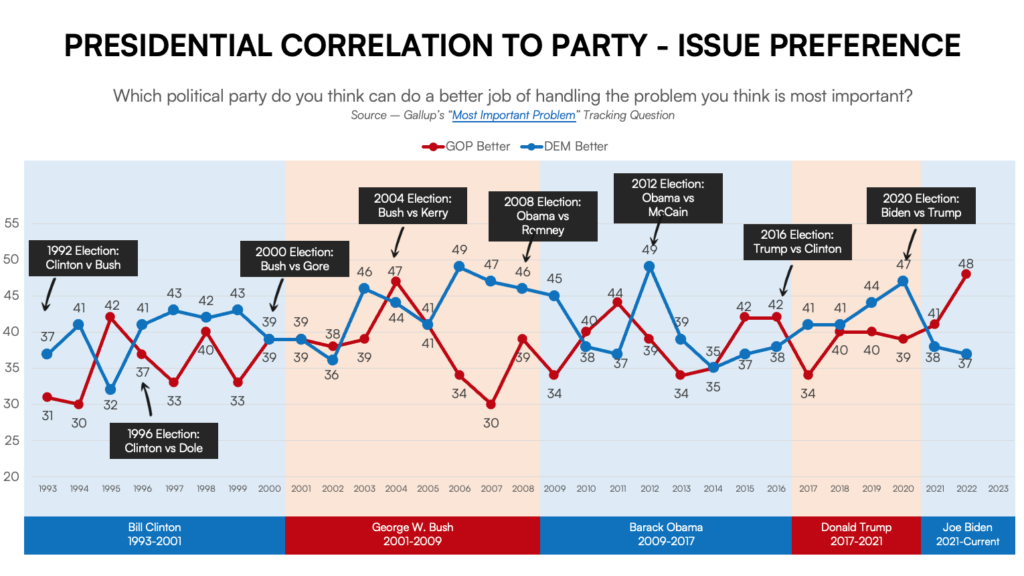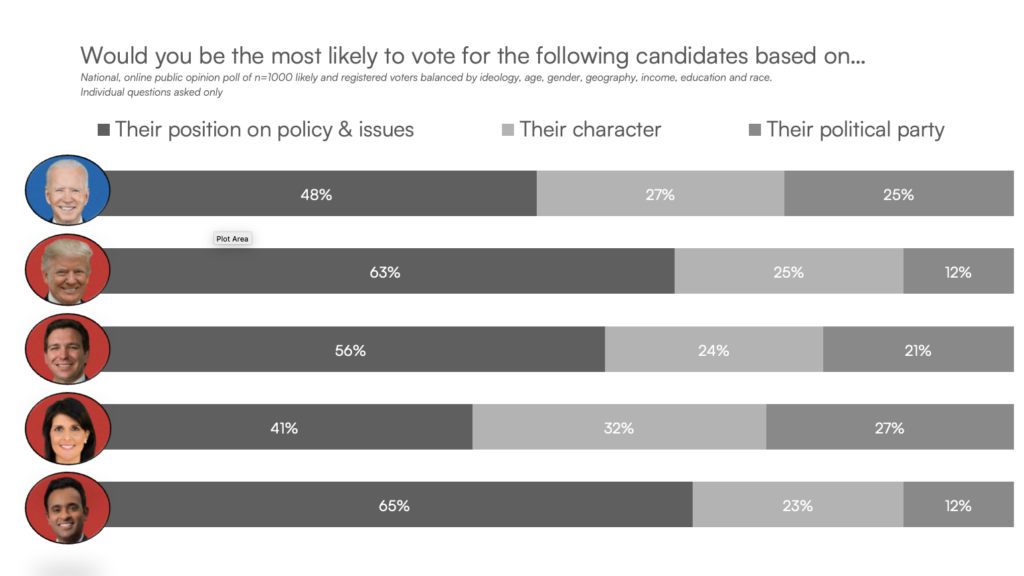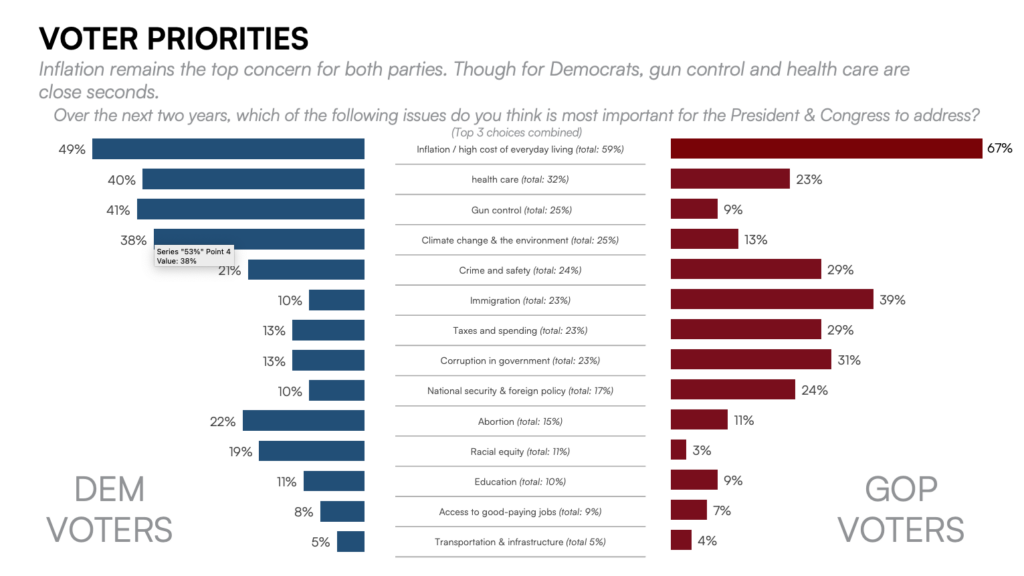10.25.23
According to Real Clear Politics’ Average as of Mid-October 2023, Biden and Trump are statistically tied in the polls. Biden 44.5%. Trump 45.2% (Trump +0.7%.) The horse race polls say they’re tied. But… are they really?
If you want to know how voters will cast their ballot in 2024, don’t ask directly. We’ve seen too many examples over the last few election cycles of unresponsive voters or savvy polltakers who knowingly subvert the system.
While it has its flaws, horse race polling is still valuable and an important indicator of election outcomes. But pollsters, candidates, the media, and news consumers alike all need to rethink their expectations for this type of polling. Winning a poll is not the same as winning an election.
If you want a more accurate predictor of outcomes, you have to go further to track sentiment surrounding the issuesthat voters care about most. As an example, take a look at Gallup’s party preference for handling voters’ “most important problem” data during modern political elections over the last 30 years. Then overlay these data on top of presidential election outcomes during the same time period.

The result: party preference on voters’ top issues positively corelates with presidential election outcomes 100% of the time.
- 1992: issue sentiment DEM +6. Result: Clinton Victory.
- 1996: issue sentiment DEM +4. Result: Clinton Victory.
- 2000: Issue Sentiment tied. Result: A too-close-to-call election & The Bush vs Gore Supreme Court Case
- 2004: issue sentiment GOP +3. Result: Bush Victory.
- 2008: issue sentiment DEM +7. Result: Obama Victory.
- 2012: issue sentiment DEM +10. Result: Obama Victory.
- 2016: issue sentiment GOP +4. Result: Trump Victory.
- 2020 issue sentiment DEM +8. Result: Biden Victory.
Exploring similar data for Biden’s presidency suggests a sobering conclusion for the incumbent in his approach to 2024. As of 2022 (most recent data at time of writing), Republicans hold the single largest advantage (+11) they’ve ever held over the last 30 years when it comes to public perception that they’re the party that will do a better job of handling the problems that voters think most important.
Base issue sentiment drives Presidential elections. In a recent poll, we asked voters why they might be voting for some of the front running candidates. The number one issue – by far – was candidates’ stance on issues and policies. Donald Trump (63%) and Vivek Ramaswamy (65%) are most closely associated with their stances on the issues amongst their respective voters who said they’d at least consider voting for them. By comparison, Biden is less closely associated with his stance on the issues. In fact, fully one quarter of people who would consider voting for Biden say he wins their vote simply because he’s the Democrat running.

These data taken together suggest a significant advantage for the likely Republican nominee, Donald Trump over President Biden – much more than current horse race polling which has the two effectively tied. Lastly, if issues have an outsized impact on the outcomes of Presidential elections (perhaps more than the candidates themselves) we should look at WHICH issues matter most.

‘Inflation and the high cost of everyday living’ is the number one issue for both Republican (67%) and Democratic (49%) voters. It has remained consistently as the top concern for the last year and a half, overtaking “COVID” in March 2022. In fact, for most of the that time, “inflation” (59%) has been answered at roughly DOUBLE the rate as any other single issue on this question.
Make no mistake, Biden’s 2024 reelection hopes rest on his ability to address how voters perceive the economy, inflation, and high consumer prices. It’s not about what the financial professionals say about the economy… or the performance of the stock market… or how the Fed takes action to curb inflation. It’s about how people feel the effects of higher prices in their daily lives.
Beyond their primary concern of inflation and high costs, Republicans and Democrats appear to have wildly different secondary priorities. Republican second-tier concern is Immigration (39%). Democrats second-tier concerns are Gun control (41%), Health care (40%), and Climate change (38%).
I say “appear” because based on focus group responses, we know that both groups’ top secondary concerns (Immigration for Republicans and Gun control for Democrats) are two sides of the same perceptional coin. Democratic voters are concerned about gun control because they believe guns pose a very real safety risk for themselves and their children. Similarly, Republican voters are concerned about immigration for the same reason – the perception that undocumented immigrants pose very real safety risk to themselves and their children. They’re talking about the same thing – existential dread.
If you’re an incumbent, an analysis of the issues reveals a significant problem about the electorate on both sides. Voters are worried about survival…about base needs… about safety rather than things like taxes, or education, or foreign policy. Not a great place to be if you’re an incumbent.
A deeper analysis of the contextual data delivers a richer picture of the current state of the 2024 election than Trump 45%; Biden 44%. But we have to think about polling in a different lens.
We must go beyond transactional “which candidate will you vote for in the upcoming election” polling. It involves exploring the prioritization and personalization of the issues. It involves how those issues impact actual voters. It involves thinking about Americans not as subsets of various different types of demographics… but as people.
People are messy. They don’t vote on a single issue, but on a mish-mash of different concerns. They change their minds. They don’t think about issues as mutually exclusive, binary choices. They can hold seemingly contradictory perceptions about different issues in their heads at one time. If you’re interested in who’s going to win an election, look beyond the horse race and explore the context and perceptions of the issues that matter most to voters who decide elections.

